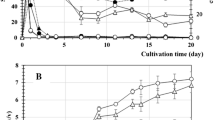Abstract
The fermented tea vinegar combines the beneficial properties of tea and vinegar. The complete fermentation takes 4 to 5 weeks in a batch culture and thus can be shortened by semi continuous/ continuous fermentation using immobilized bacterial cells. In the present study, alcoholic fermentation of 1.0 and 1.5% tea infusions using Saccharomyces cerevisae G was carried out that resulted in 84.3 and 84.8% fermentation efficiency (FE) respectively. The batch vinegar fermentation of these wines with Acetobacter aceti NRRL 746 at the initial 1% acidity yielded 4.5 and 4.7% volatile acidity with 71.4 and 73% FE in 24 days. The semi continuous fermentation using sugarcane bagasse adsorbeded A.aceti cells produced 4.4% of volatile acidity from 1.5% tea wine (8.9% ethanol and 1.0% acidity), in 9 flow cycles, each of 4 h duration in a fermentation column at 50 ml/h. In the scale up process, 600 ml 1.5% tea wine produced 4.3% volatile acidity at 42.7% FE in 9 flow cycles of 12 h duration each.
Similar content being viewed by others
References
Amerine MA, Berg HW, Guess NC (1967) Evaluation of wines and brandies. In: The Technology of wine making, 2nd edn, The Avis Publ. Co., Inc., Westport, USA, p 678–730
AOAC (1980) Official methods of analysis, 13th edn. Association of Official Analytical Chemists, Washington
Caputi A Jr, Wright D (1969) Collaboration study for the determination of ethanol in wine by chemical oxidation. J Assoc Off Anal Chem 52:85–88
Chand P, Gopal R (2005) Nutritional and medicinal improvement of black tea by yeast fermentation. Food Chem 89:449–453
Fregapane G, Rubio FH, Desamparados SM (2003) Continuous production of vinegar in bubble column reactor of upto 60 litre capacity. Eur Food Res Technol 216:63–67
Garg N, Tandon DK, Kalra SK (1995) Production of mango vinegar by immobilized cells of Acetobacter aceti. J Food Sci Technol 32:216–218
Guttapadu S, Yang Z, Knol W (2000) Kombucha fermentation and its antimicrobial activity. J Agric Food Chem 48:2589–2594
Horzic D, Komes D, Belscak A, Ganic KK, Ivekovic D, Karlovic D (2009) The composition of polyphenols and methylxanthines in teas and herbal infusions. Food Chem 115:441–448
Hui YH (1992) Tea. In: Hui YH (ed) Encyclopedia of food science and technology, vol. 4. Wiley, USA, pp 2525–2537
Jiranek V, Langridge P, Henschke PA (1995) Amino acid and ammonium utilization by Saccharomyces cerevisiae wine yeast from a chemically defined medium. Am J Enol Viticulure 46:75–83
Johnston CS (2006) Vinegar: Medicinal uses and antiglycemic effect. Med Gen Med 8(2):61
Kaur M, Kocher GS (2002) Ethnaol production from molasses and sugarcane juice by an adapted strain of Saccharomyces cerevisiae. Indian J Microbiol 42:255–257
Kim DH (1999) Study on production of vinegar from fig. Korean Soc Food Sci Nutr 28:53–60
Kocher GS, Kalra KL, Tewari HK (2003) Production of vinegar from cane juice. In: Electronic proceedings of Symp Food and Nutritional Security: Technological Interventions and Genetical options, (In Late arrivals), Sept 18-19, HPKVV, Palampur, India
Kocher GS, Kalra KL, Phutela RP (2006) Comparative production of sugarcane vinegar by different immobilization techniques. J Inst Brew 112:264–66
Lane J, Eynon J (1923) Determination of reducing sugars by Fehling’s solution with methylene blue as indicator. J Soc Chem Ind Trans 42:32–36
Liyanage AC, Silva MJ, Ekanayaka A (1988) Analysis of major fatty acids in tea. SriLanka J Tea Sci 3:46–49
Lu SF, Lee FL, Chen HK (1999) A thermotolerant and high acetic acid producing bacterium Acetobacter sp. 114–2. J Appl Microbiol 86:55–62
Wrobel K, Urbina EM (2000) Determination of total aluminium, chromium, copper, iron, manganese and nickel and their fraction leached to the infusion of black tea, Hibiscus sabdariffa and Ilex paraguariensis by ETA-AAS. Biol Trace Elem Res 78:271–280
Yamagishi K, Kimura T, Kameyama M, Nagta T, Kikuchi Y (1998) Purification and identification of blood fluidity improvement factor in brewed rice vinegar (Kurosu). J Japan Soc Food Sci Technol 45:545–549
Acknowledgement
Authors duly acknowledge Swezy and Rooney of Microbial Genomics and Bioprocessing research unit, USDA, Illinois, USA for providing the Acetobacter aceti NRRL 746 culture.
Author information
Authors and Affiliations
Corresponding author
Rights and permissions
About this article
Cite this article
Kaur, P., Kocher, G.S. & Phutela, R.P. Production of tea vinegar by batch and semicontinuous fermentation. J Food Sci Technol 48, 755–758 (2011). https://doi.org/10.1007/s13197-010-0143-9
Revised:
Accepted:
Published:
Issue Date:
DOI: https://doi.org/10.1007/s13197-010-0143-9



